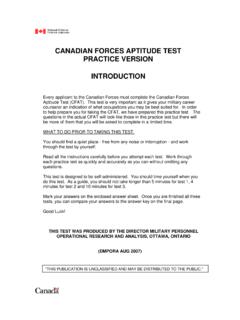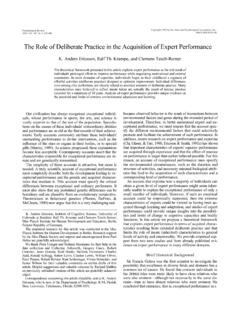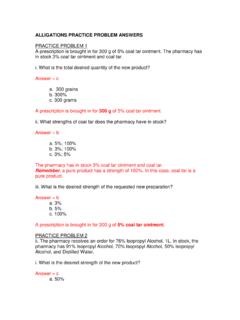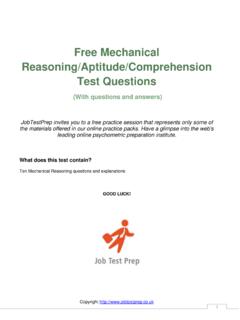Transcription of Mechanical and Spatial Aptitude - Tripod
1 MECMECHANICHANICAL &AL &SPSPAATIAL TIAL APTITUDEAPTITUDEMECMECHANICHANICAL &AL &SPSPAATIAL TIAL APTITUDEAPTITUDENew YorkCopyright 2001 LearningExpress, rights reserved under International and Pan-American Copyright in the United States by LearningExpress, LLC, New of Congress Cataloging-in-Publication Data: Mechanical and Spatial (Skill builders series)ISBN 1-57685-357-81. Mechanical Ability Examinations, questions, etc. 2. Space perception Examinations, questions, etc. 3. Reasoning (Psychology) Examinations,questions, etc. I. LearningExpress (Organization) II. Skill builders series(New York, ) M44 '462 dc212001016501 Printed in the United States of America9 8 7 6 5 4 3 2 1 First EditionISBN 1-57685-357-8 For Further InformationFor information or to place an order, contact LearningExpress at:900 BroadwaySuite 604 New York, NY 10003Or visit our website GETTING READY FOR A Mechanical / Spatial Aptitude TEST2 THE LEARNINGEXPRESS TEST PREPARATION SYSTEM3 Mechanical APTITUDEShop ArithmeticTool KnowledgeMechanical InsightMechanical Knowledge4 Spatial CONCEPTSH idden FiguresBlock CountingRotated BlocksMatching Pieces and PartsSpatial AnalysisUnderstanding PatternsEye hand CoordinationReading Maps5 INTERPRETING SYMBOLSS ymbol SeriesSymbol AnalogiesSorting and Classifying FiguresSeries Reasoning Test6 DIAGNOSTIC TEST PRACTICE WHAT YOU HAVE LEARNEDP ractice QuestionsCONTENTSL earningExpress Mechanical & Spatial Aptitude CHAPTER 11C H A P T E RCHAPTER SUMMARYIf you re the kind of person who has always been fascinatedwith gears and pulleys, nuts and bolts, and electrical mazes,this book is for you!
2 In fact, you are probably the same per-son who can think in 3D and can use your natural mechan-ical/ Spatial abilities for your career. Chances are yourabilities will put you in a good position to take any kind ofexam that tests Mechanical / Spatial Aptitude . Rememberthough, that practice makes perfect in the long run. That swhy you re reading this ability to understand and use Mechanical devices is critical fora job in many fields. Whether you decide to enter the military, applyfor a government job, or take a job in private industry, you ll haveto take an entrance test that determines your skills and abilities. The mil-itary requires that all candidates take the ASVAB (Armed Services Voca-tional Aptitude Battery) test. Many government positions (local, state, andfederal) require you to take an entrance level exam that measures your you want to be a police officer or firefighter, your ability to use mechan-ical devices and solve Spatial concepts problems is very important and showsup on most every who work in the professions that require Mechanical /spatialability use many different Mechanical devices every day.
3 Simple hand toolsGETTING READY FOR AMECHANICAL/SPATIALAPTITUDE TEST11 CHAPTER 1 LearningExpress Mechanical & Spatial Aptitude2such as axes and wrenches, as well as more complex sys-tems such as pumps and internal combustion enginesare standard tools of the trade. Spatial concepts go hand-in-hand with Mechanical the exam you have to take includes a section onmechanical Aptitude , it may cover topics with which youare very familiar, as well as some that are new. If theexam covers Spatial Aptitude , you ll get lots of practicesolving that kind of problem as this introductory chapter, you ll find a fewsample questions to try. Next, you ll be given many prac-tice questions designed to improve your Mechanical , Spatial , and symbol reasoning abilities. Last, you can takea diagnostic test to practice what you have of your background, understanding theconcepts in this book will benefit you on an examdesigned to test your Mechanical / Spatial ISMECHANICALABILITY?
4 Basically, Mechanical ability means that you can under-stand Mechanical principles, devices, and tools, and theeveryday physics that make them work. You also havethe ability to reason and understand the direction ofmovement of gears in a system of gears. In addition, youcan see the patterns of moving parts in engines devices are an integral part of every-day life. When you imagine the numbers of cars on thehighways, offices with machines and computers thatmake routine office duties easier, and the recreationalvehicles used for vacations, you can quickly calculatethat a person with Mechanical abilities will have lots ofwork to do in a Aptitude questions tend to cover awide range of topics. The questions will usually be mul-tiple choice with four or five possible answers. Somequestions may require previous knowledge of the topicwhile other questions will include all of the informa-tion you need to choose an typical Mechanical Aptitude question will looksomething like this:Which of the following is a common component of aninternal combustion engine?
5 Hydraulic jackThe answer is a, a piston. A compass is used todetermine a direction on a map. A hammer is used todrive nails. A hydraulic jack is used to lift heavy exams may test your knowledge of varioussystems or combinations of Mechanical devices. Acommon example of a Mechanical system is the inter-nal combustion engine of an automobile. Other ques-tions will require the identification of variousmechanical tools or devices like hand tools, gears, pul-leys, levers, fasteners, springs, valves, gauges, and IS AMECHANICALDEVICE?A Mechanical device is a tool invented to make a giventask easier. For example, you could drive a nail into apiece of wood with a rock. However, a long time ago,a woodworker must have decided that there had to bea better way. A long slender handle with a hard pieceof metal for striking the nail provided more accuracyand did not damage the wood as easily. Thus was bornthe hammer. GETTING READY FOR A Mechanical / Spatial Aptitude TEST LearningExpress Mechanical & Spatial Aptitude CHAPTER 13 Most Mechanical devices were invented in thesame manner people looking for easier ways to per-form their everyday jobs.
6 Some Mechanical devices the lever, the wheel, and many hand tools arethousands of years old. Other more complex devices,such as pumps and valves, were invented more times the idea of a new Mechanical device existsbut the technology to design it does not. For example,many years before the pump was invented, peopleprobably discussed the need for an easier way to movewater from the river to the town on the hill. However,the technologies of the electric motor and casting ofmetal had not yet been invented, so the modern pumpcould not possibly have been invented at that devices cover a wide range and vari-ety of tools. In general, Mechanical devices are tools thatrelate to physical work and are governed by mechani-cal forces and movements. You can usually see what theydo and how they work as opposed to, say, a light switchor a battery, which are electrical devices. Some tools areused to directly accomplish a specific task, such aswhen you use a handsaw to cut a piece of wood.
7 Oth-ers, such as pulleys and gears may be used indirectly toaccomplish certain tasks that would be possible with-out the device but are easier with the device. Still oth-ers, such as gauges, only provide feedback informationon the operation of other Mechanical devices. In yourdaily life, you see and use Mechanical devices manytimes each day, so there s no reason to be intimidatedby a Mechanical Aptitude section on any TOOLSHand tools are defined as tools operated not by motorsbut rather by human power. There are many differenttypes of hand tools including carpentry tools and auto-motive hand tools as well as hand tools specific to dif-ferent trades. Since it is impossible to cover everyconceivable kind of hand tool, this chapter lists anddefines some of the hand tools used in everyday situ-ations and the ones you are most likely to be of the hand tools used by carpenters andother workers are listed on the table on the of the hand tools used in the automotiveindustry are listed below.
8 Wrenchesare used to tighten and loosennuts and bolts. Examples include open endand box end wrenches, crescent, and pipewrenches. Mechanical jacksare used to lift cars so thattires can be changed. The jack in the trunk ofyour car is an example. Pliers are small pincers with long jaws forholding small objects or for bending and cut-ting wire. Examples are cutting pliers, electri-cal pliers, and long-nosed pliers. In addition,vice grips are considered locking pliers. Screwdrivers are tools used for loosening,tightening, or turning screws. Examples arePhillips and straight blade screwdrivers. Sockets and ratchetsare used like wrenchesto loosen, remove, or tighten nuts and bolts;there are many different sizes. Torque wrenches are used to measure thetightness, , the proper torque, of a nut orbolt. Gear pullers are used to remove gears andpulleys. GETTING READY FOR A Mechanical / Spatial Aptitude TEST GEARSA gear is generally a toothed wheel or cylinder thatmeshes with another toothed element to transmitmotion or to change speed or direction.
9 Gears are typ-ically attached to a rotating shaft turned by an outsideenergy source such as an electric motor or an internalcombustion engine. Gears are used in many mechan-ical devices including automotive transmissions, bicy-cles, and carnival rides such as Ferris wheels can be used in several different configura-tions. Two gears may be connected by directly touch-CHAPTER 1 LearningExpress Mechanical & Spatial Aptitude4 GETTING READY FOR A Mechanical / Spatial Aptitude TEST HAND TOOLSToolDescription/FunctionExamplesham merused primarily to drive and remove nails, as well as to claw hammer, rubberpound on devices such as chiselsmallet, ball-peen hammersawthin metal blade with a sharp-toothed edge used to cut handsaw, hacksaw, wood or metaljigsawscrewdriverused to tighten and loosen screws and boltsslotted (regular) head, Phillips headleveltwo- to four-foot long piece of metal or plastic that hand level, laser levelcontains calibrated air bubble tubes, used to ensure that things are vertically plumb or horizontally levelsquareused primarily to aid in drawing a cut line on a board L-square, T-squareto insure a straight, ninety-degree cutplanemetal tool with a handle and an adjustable blade, used block plane, various sizes to shave off thin strips of wood for the purpose of of carpenter s planessmoothing or levelingchiselmetal tool with a sharp, beveled edge that is struck scoop chisel, beveledwith a hammer in order to cut and shape stone, metal, chisel, masonry chisel,or woodcold chiselprotractorhalf-circle with tick marks around the edge spaced at only one type, made of one-degree intervals, used to measure anglesmetal or plasticC-clampC-shaped metallic instrument with a threaded stop that furniture clamps.
10 Many can be adjusted to clamp together pieces of material of types and sizes of metallic different thicknessesC-clampscompassV-shaped metallic instrument with a sharp point on the only one type existsend of one leg and a pencil or pen on the end of the other leg, used to draw circlesLearningExpress Mechanical & Spatial Aptitude CHAPTER 15ing each other as in an automotive transmission. In thisarrangement, one gear spins clockwise and the otherrotates counter-clockwise. Another possible configu-ration is to have two gears connected by a loop of chainas on a bicycle. In this arrangement, the first gearrotates in one direction causing the chain to move. Sincethe chain is directly connected to the second gear, thesecond gear will immediately begin to rotate in the samedirection as the first times a system will use two gears of differ-ent sizes as on a ten-speed bicycle. This will allowchanges in speed of the bicycle or about gears will always involve rotationor spinning.










